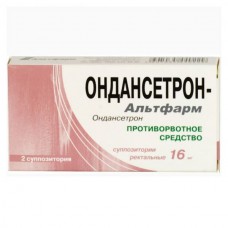Expiration date: 06/2026
Release form and composition:
Rectal suppositories white or white with kremovatam ottenkom color, torpedo-shaped, with no visible inclusions on the longitudinal section.
Excipients: witepsol N-15.
5 PCs. - packaging sells contoured (1) - packs of cardboard.
Rectal suppositories white or white with kremovatam ottenkom color, torpedo-shaped, with no visible inclusions on the longitudinal section.
1 suppositorie contains:
ondansetron 4 mg
Excipients: witepsol N-15.
5 PCs. - packaging sells contoured (1) - packs of cardboard.
Rectal suppositories white or white with kremovatam ottenkom color, torpedo-shaped, with no visible inclusions on the longitudinal section.
1 suppositorie contains:
ondansetron 8 mg
Excipients: witepsol N-15.
1 PCs. - packaging sells contoured (1) - inserts made of cardboard (2) - packs of cardboard.
Pharmacological action:
Antiemetic drug of Central action. Selective antagonist of serotonin 5HT3 receptors.
Medicine for cytotoxic chemotherapy and radiotherapy may cause increased levels of serotonin, which by activation of vagal afferent fibers containing serotonin 5HT3-receptors, causes a gag reflex. Ondansetron inhibits the appearance of the gag reflex by blockade of serotonin 5HT3 receptors at the level of neurons, both Central and peripheral nervous system. Apparently, this mechanism of action is based the prevention and treatment of postoperative and caused by cytotoxic chemotherapy and radiotherapy nausea and vomiting.
Pharmacokinetics:
Pharmacokinetic parameters of ondansetron do not change when its repeated administration.
Suction
After a rectal ondansetron is determined in plasma after 15-60 min, the Concentration of active substance increases linearly Cmax is reached after about 6 h and is 20-30 ng/ml. the Absolute bioavailability of rectal administration is approximately 60%. The decline in plasma concentration occurs at a slower rate than after ingestion (due to continued absorption).
Excretion
T1/2 is 6 h.
Indications:
- prevention and elimination of nausea and vomiting caused by cytotoxic chemotherapy and radiotherapy.
Dosing regimen:
The drug is used rectally. To remove the suppository from the packaging cell, you should break off a single cell with the suppository at the notch and having separated edges of the tape, pulling them in different directions. Suppository inserted into the anus pointed end, possibly deep. For more convenient introduction of a suppository is recommended to bend, squat or lie on side, legs crossed.
The choice of dosage regimen is determined by the severity emetogenic actions carried out by anti-cancer therapies.
At a moderate emetogenna chemotherapy or radiotherapy administered 16 mg of ondansetron 1-2 hours prior to primary therapy.
In case of high emetogenic chemotherapy, the recommended dose is 16 mg simultaneously with I/V introduction of 20 mg dexamethasone for 1-2 hours before start of chemotherapy.
For the prevention of late or prolonged vomiting occurring 24 hours after chemotherapy or radiotherapy, should continue taking the drug at a dose of 16 mg 1 times/day for 5 days.
The drug is not recommended for use in children.
In elderly patients changes in dose is not required.
In patients with renal insufficiency not require a change of dose, frequency of administration, or method of application.
For patients with impaired hepatic function a daily dose of ondansetron should not exceed 8 mg.
Patients with a slow metabolism sparteine/debrisoquine correction daily dose or frequency of administration of ondansetron is not required.
Side effects:
From the digestive system: hiccups, dry mouth, constipation, diarrhea, sometimes asymptomatic transient elevation of transaminases in blood serum.
From the side of cardiovascular system: chest pain (sometimes with depression of the ST segment), arrhythmia, bradycardia, decrease in blood pressure.
From the nervous system: headache, dizziness, spontaneous movement disorders, seizures.
Allergic reactions: urticaria, bronchospasm, laryngospasm, angioedema, anaphylaxis.
Local reactions: redness, pain, a burning sensation in the anus and rectum after administration of the suppository.
Other: a rush of blood to the skin, hot flashes, temporary violation of visual acuity, hypokalemia, gipercreatininemia.
Contraindications:
- pregnancy
- lactation (breast feeding)
- children's age
- hypersensitivity to ondansetron or any component of the drug.
Pregnancy and lactation:
The drug is contraindicated during pregnancy and lactation (breastfeeding).
Special instructions:
Patients with a history of allergic reactions to other selective blockers of serotonin 5HT3-receptors, have an increased risk of their development when taking ondansetron.
Ondansetron may slow down the motility of the large intestine, therefore, his appointment of patients with symptoms of intestinal obstruction requires special monitoring.
Overdose:
There is limited experience of ondansetron overdose. In most cases, symptoms similar to adverse reactions when using the drug in the recommended doses.
Treatment: symptomatic and supportive therapy. The specific antidote to ondansetron is not known.
Drug interactions:
There is no evidence that ondansetron induces or inhibits the metabolism of other drugs commonly prescribed in combination with it.
Ondansetron is metabolized by several isoenzymes of cytochrome P450 (CYP3A4, CYP2D6 and CYP1A2). Inhibition or reduced activity of one of the isoenzymes normally kompensiruet other, therefore a significant decrease in the total clearance of ondansetron is unlikely. However, caution is required if joint application:
- with inducers of isoenzymes of cytochrome P450 (CYP2D6 and CYP3A): barbiturates, carbamazepine, carisoprodol, glutethimide, griseofulvin, dinitrogen oxide, papaverine, phenylbutazone, phenytoin (probably other hydantoins), rifampin, tolbutamide
- with inhibitors of isoenzymes of cytochrome P450 (CYP2D6 and CYP3A): allopurinol, macrolide antibiotics, antidepressants (MAO inhibitors), chloramphenicol, cimetidine, oral contraceptives containing estrogens, diltiazem, disulfiram, valproic acid, sodium valproate, erythromycin, fluconazole, fluoroquinolones, isoniazid, ketoconazole, lovastatin, metronidazole, omeprazole, propranolol, quinidine, quinine, verapamil.
Special studies have shown that ondansetron does not interact with ethanol, temazepam, furosemide, tramadol and propofol.
Terms and conditions of storage:
The drug should be stored in a dry, dark, inaccessible to children at temperature not exceeding 25°C. shelf Life - 2 years.


